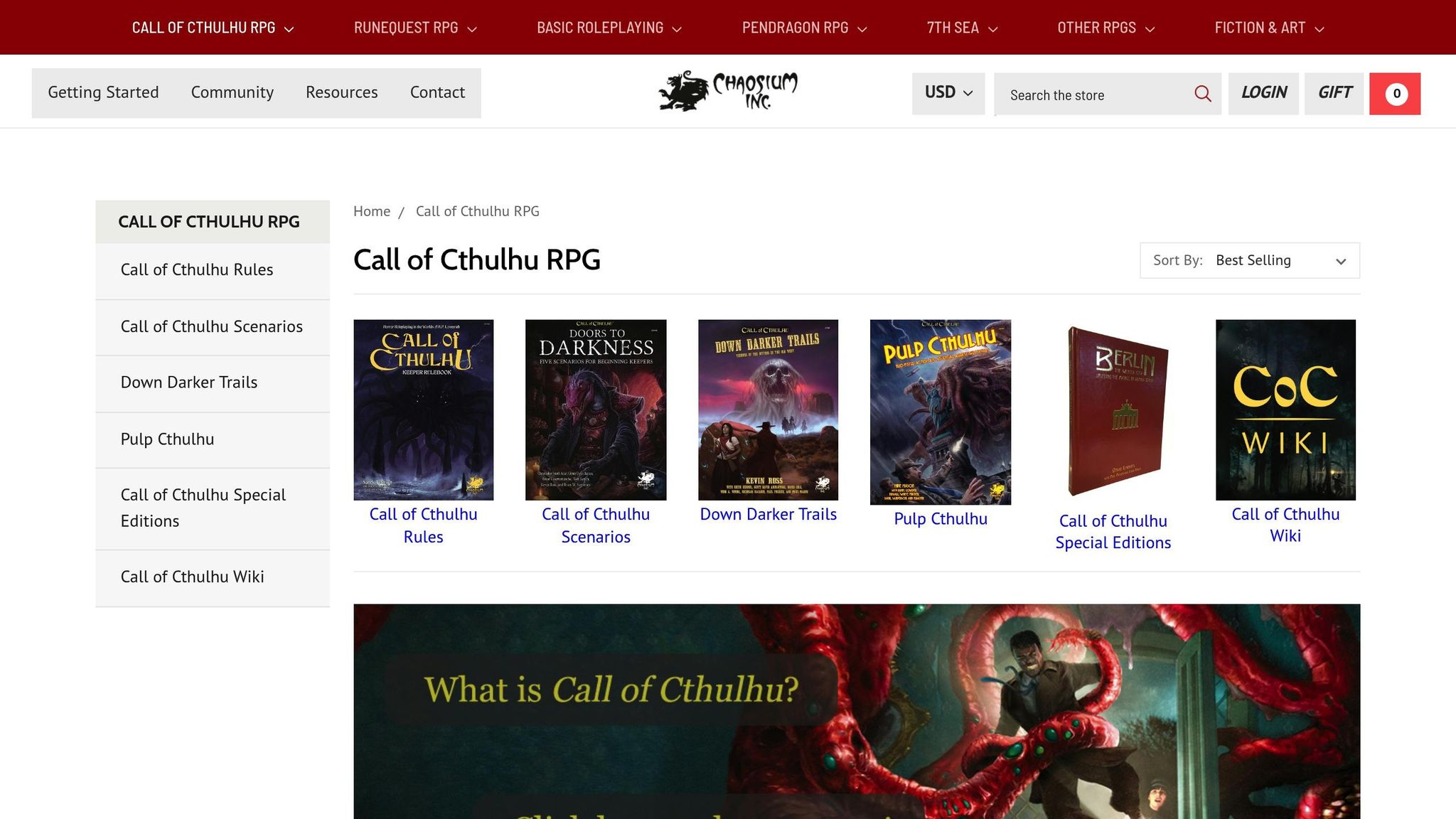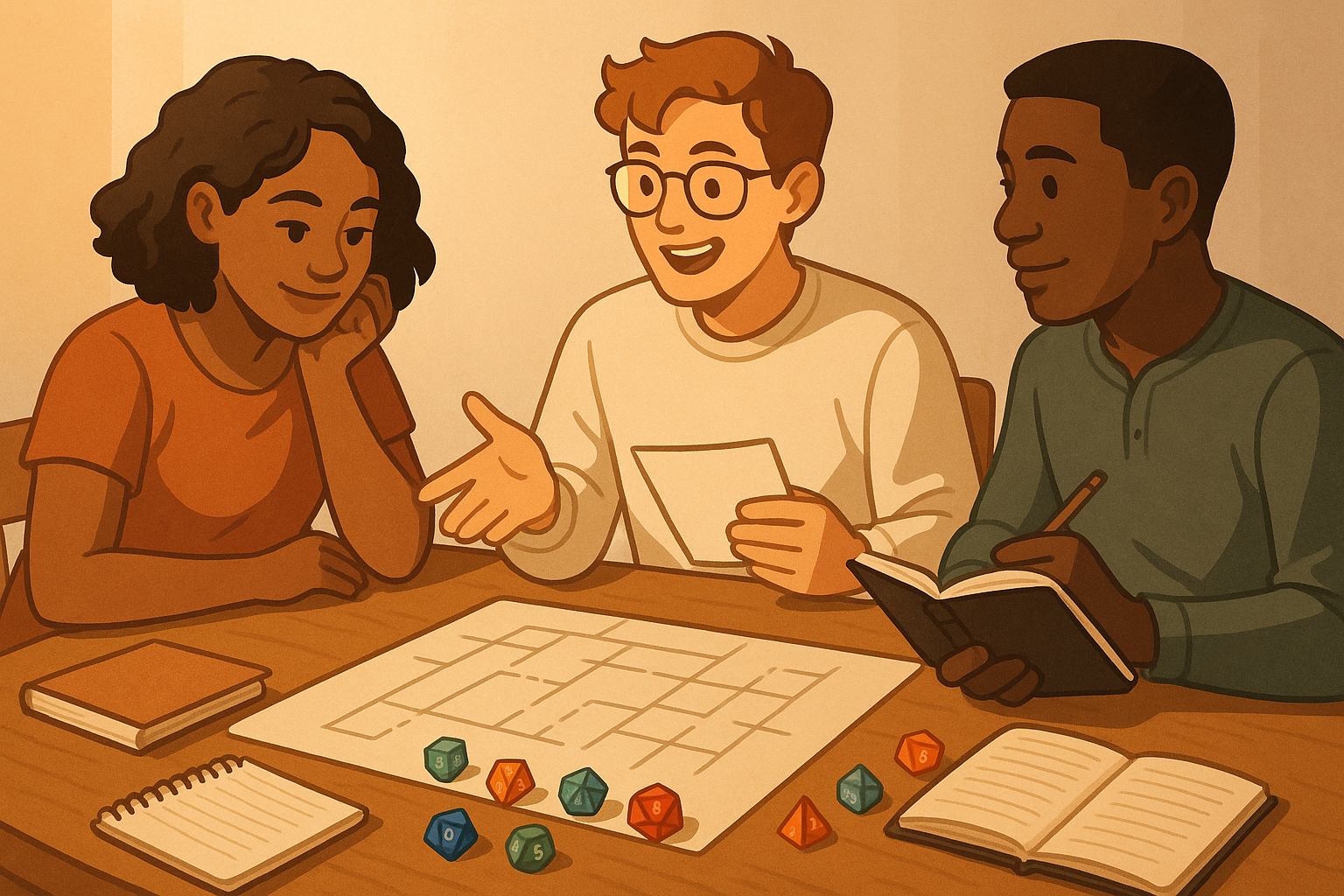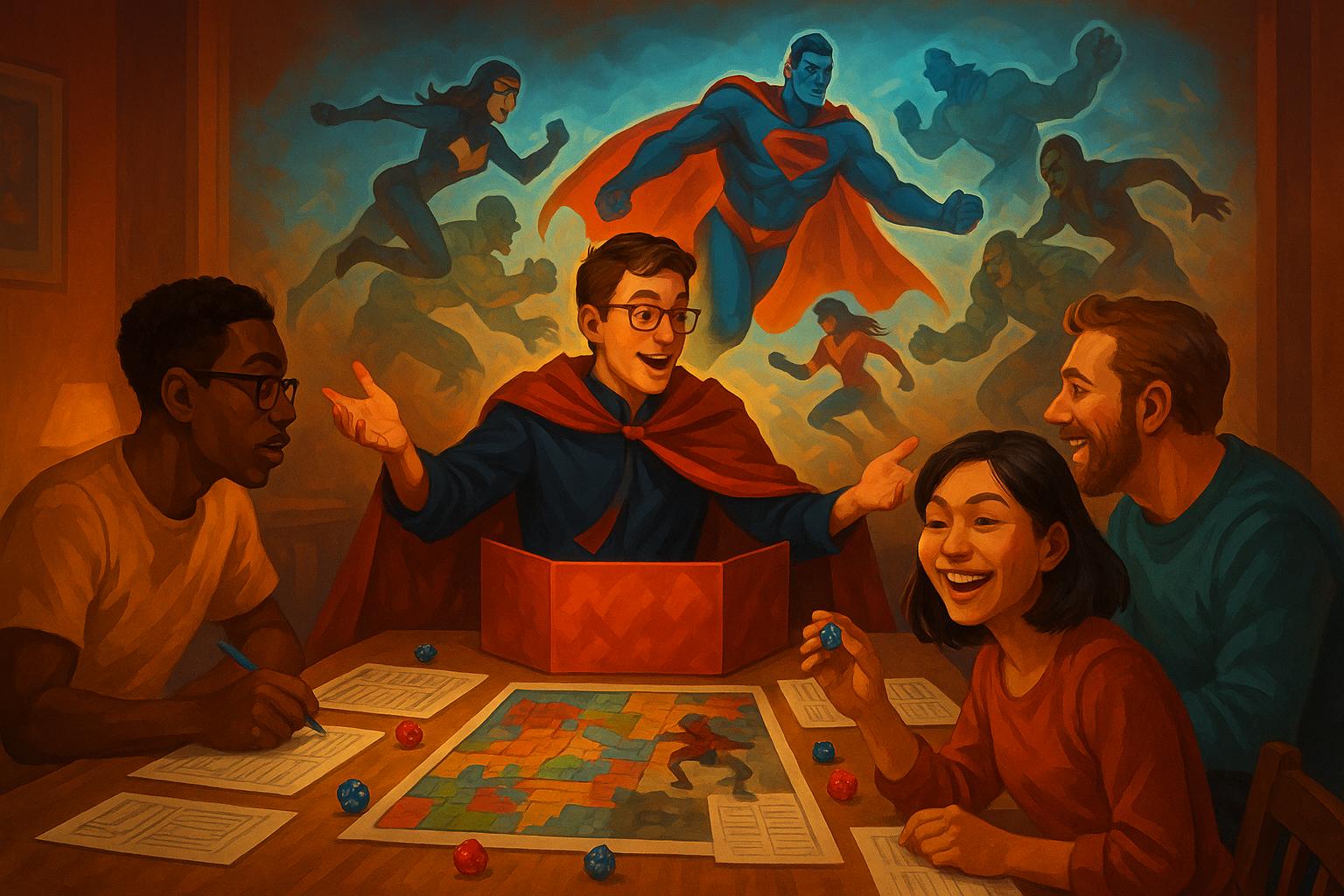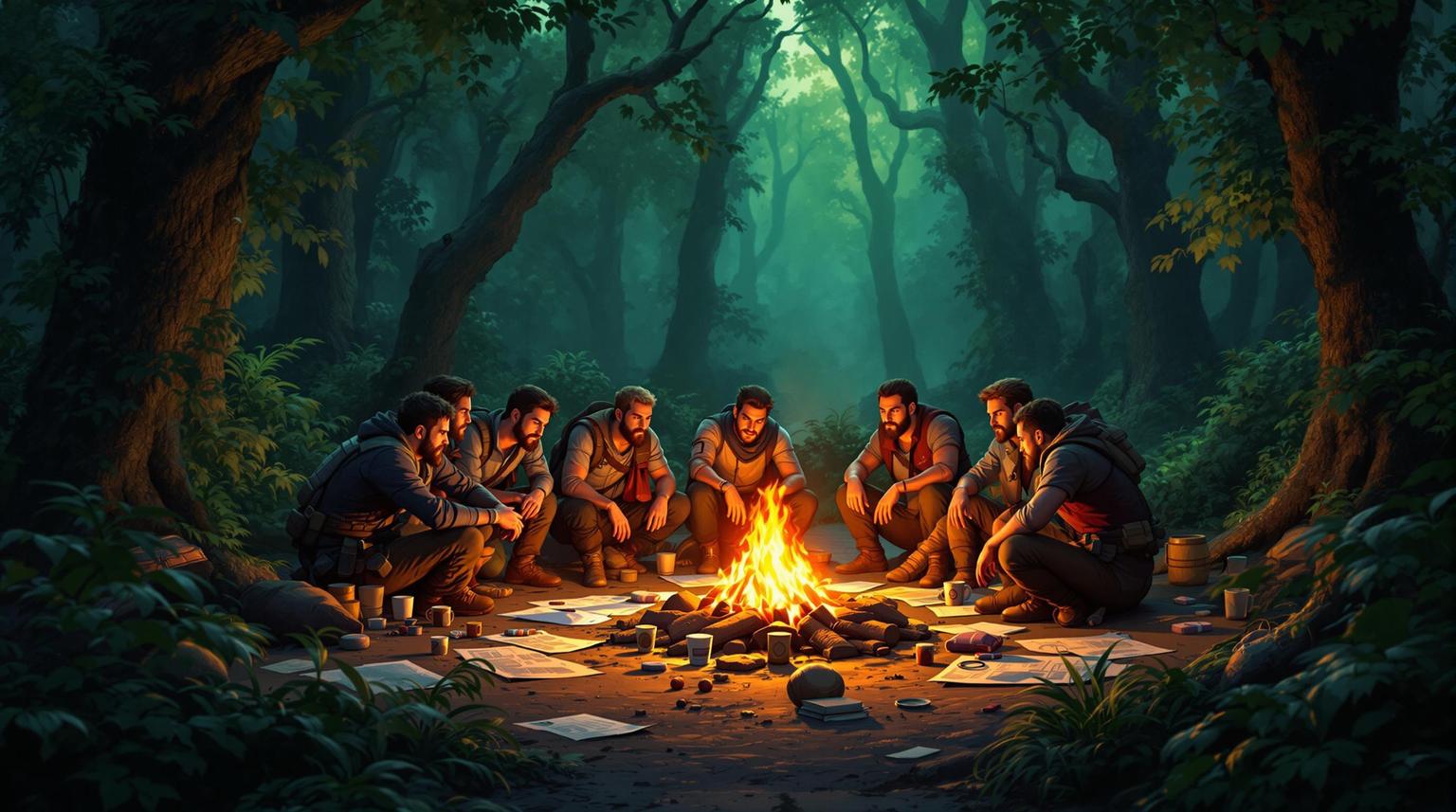In tabletop role-playing games (TTRPGs), the size of your group significantly affects gameplay, storytelling, and pacing. Here's a quick guide to the ideal party sizes for popular systems:
- D&D 5e: Best with 4–6 players. This range balances combat, story engagement, and role coverage (e.g., tank, healer, damage dealer, spellcaster).
- Pathfinder 2e: Works well with 3–5 players. Four players offer tactical depth and balanced encounters, with flexible class roles.
- Call of Cthulhu: Thrives with 3–5 players. Smaller groups enhance investigative gameplay and maintain tension in horror elements.
- Powered by the Apocalypse (PbtA): Ideal with 3–4 players. This size keeps storytelling tight and ensures everyone has spotlight time.
Quick Comparison
| System | Ideal Party Size | Key Features |
|---|---|---|
| D&D 5e | 4–6 players | Balanced combat, diverse roles, dynamic storytelling. |
| Pathfinder 2e | 3–5 players | Tactical combat, flexible roles, efficient pacing. |
| Call of Cthulhu | 3–5 players | Investigative focus, tense atmosphere, intimate horror. |
| PbtA Games | 3–4 players | Narrative-driven, rich character interactions, fast pacing. |
Each system is designed with specific group sizes in mind, but adjustments can make any size work. For smaller groups, simplify encounters; for larger groups, focus on time management and player inclusion.
What Size Should Your D&D Party Be?
1. D&D 5e Party Size
In Dungeons & Dragons 5th Edition (D&D 5e), the sweet spot for party size is typically 4–6 players, with 5 being the ideal number. This range strikes a great balance between dynamic combat and giving each character a moment to shine. It keeps the game manageable for the Dungeon Master while allowing players to feel like their actions carry weight in both battles and storytelling.
Class Distribution
With a party of 4–6, players can easily cover a variety of class roles, ensuring the group is well-rounded. Common archetypes include:
- Tank: Fighters, Paladins, or Barbarians to absorb damage and protect the team.
- Healer: Clerics or Druids to keep everyone standing.
- Damage Dealer: Rangers, Rogues, or Warlocks to dish out consistent damage.
- Spellcaster: Wizards or Sorcerers to bring powerful magic to the table.
- Support: Bards or Artificers to buff allies and provide utility.
This mix not only adds strategic depth to combat but also creates opportunities for every player to contribute to the story in meaningful ways. With each role covered, the party is equipped to handle a variety of challenges, from dungeon crawls to epic boss fights.
2. Pathfinder 2e Group Size

Pathfinder 2e, like D&D 5e, suggests an ideal party size to balance its intricate combat system and storytelling elements. The sweet spot? A group of 3-5 players, with 4 players often providing the best mix of tactical depth and narrative engagement.
Combat Balance
The game’s combat mechanics shine brightest with a 4-player setup. This size ensures:
- Quick and dynamic combat rounds with plenty of tactical decisions.
- Balanced encounter difficulty, keeping fights engaging but fair.
- Boss battles that feel challenging without overwhelming the party.
Party Composition
Pathfinder 2e’s class system thrives on specialization, but it also allows flexibility in how roles are filled. A well-rounded 4-player group might look like this:
| Role | Function | Suggested Classes |
|---|---|---|
| Defender | Absorbs damage, controls the field | Champion, Fighter |
| Healer | Provides healing and support | Cleric |
| Striker | Deals high damage to single targets | Rogue, Ranger |
| Utility | Handles crowd control and problem-solving | Wizard, Bard |
This setup ensures a balance of offense, defense, and versatility, covering most challenges a campaign might throw at the party.
Story Flow
With 4 players, the narrative stays tight, and decision-making feels efficient without overshadowing individual contributions. A smaller group of 3 players might face tougher combat scenarios but can still enjoy a rich story. On the other hand, groups larger than 5 can slow down combat rounds and make it harder for each character to get their moment in the spotlight. However, Pathfinder 2e equips Game Masters with tools to tweak encounters, making it easier to adapt to non-standard party sizes.
For Game Masters, adjusting encounters to suit the group size is key to maintaining both the tactical excitement and the flow of the story. This balance between mechanics and narrative is a central theme in how party size shapes the Pathfinder 2e experience, as we’ll explore further.
3. Call of Cthulhu Groups

The investigative horror at the heart of Call of Cthulhu means group size plays a crucial role in shaping the experience. Unlike combat-heavy games, this system thrives with smaller, tightly-knit groups - typically 3 to 5 players. A group of 4 often strikes the perfect balance between unraveling mysteries and maintaining the eerie tension the game is known for.
Investigation Balance
Because investigation is central to the game, each player’s role needs to fit into the larger puzzle. A 4-player team can effectively split responsibilities between key areas like:
- Research and analysis
- Social interactions and persuasion
- Physical exploration
- Technical problem-solving
This setup ensures that no clue goes unnoticed and every player has a unique contribution, all while keeping the atmosphere tense and engaging.
Horror Elements
The smaller the group, the easier it is to immerse everyone in the horror. With 3 to 5 players, Keepers (the game’s storytellers) can focus on:
- Crafting intimate, spine-chilling moments
- Building suspense during investigations
- Highlighting each character’s vulnerabilities
- Developing individual story arcs
This size allows for a more personal and intense experience, where the fear feels real and the stakes are high.
Skill Distribution
In Call of Cthulhu, a well-rounded group is key to solving mysteries and surviving the horrors. Players should specialize in different areas to avoid overlap and ensure all investigative bases are covered. A 4-player team, for example, can divide expertise among research, combat, social skills, and technical knowledge, creating a cohesive and efficient group dynamic.
Size Considerations
When it comes to group size, both extremes present unique challenges:
- More than 5 players: The horror can lose its edge, investigations may drag, and individual players might feel sidelined.
- Fewer than 3 players: The group may lack the skills needed to tackle challenges, leaving characters more exposed to danger.
For larger groups, Keepers can split the players into smaller teams or introduce NPC allies to maintain focus and pacing. On the other hand, smaller groups might benefit from adjusted scenarios, like easier skill checks or additional resources, to keep the game balanced. No matter the size, tailoring the experience ensures the suspense and immersion that make Call of Cthulhu unforgettable.
sbb-itb-b8b00a5
4. PbtA Games Group Size
Powered by the Apocalypse (PbtA) games shine brightest with smaller, more focused groups. While games like D&D 5e and Pathfinder 2e emphasize tactical balance, PbtA thrives on intimate storytelling, which works best in compact settings. Most PbtA games suggest 3–5 players plus a Game Master (MC), a setup that supports storytelling while keeping the pace lively.
Optimal Player Count
A group of 4 players often hits the sweet spot for PbtA games. This size ensures:
- Rich character interactions
- Plenty of spotlight time for everyone
- Manageable storylines
- Quick and smooth resolution of moves
This setup mirrors the intimate, narrative-driven structure that defines PbtA systems.
Move Mechanics and Character Dynamics
With 3–5 players, the game's move mechanics flow effortlessly, giving each player the chance to shine. PbtA playbooks are designed to complement one another in smaller groups, making every choice feel impactful. This dynamic fosters deeper collaboration and keeps the story engaging.
Size Impact on Story
Smaller groups allow the MC to weave individual character arcs seamlessly into the larger narrative. This setup amplifies the weight of each player's decisions, creating a more immersive and emotionally engaging experience.
Managing Different Group Sizes
Straying outside the recommended group size can disrupt the pacing and clarity of the story. Just like other RPG systems, sticking to the ideal range helps maintain the balance between narrative depth and gameplay flow.
Size Impact Analysis
The size of a party plays a crucial role in shaping game balance, encounter difficulty, and the overall pacing of a tabletop RPG session. For Game Masters, understanding how party size influences these factors is essential for creating an engaging experience.
Here’s a quick breakdown of how popular TTRPG systems handle party size and balance:
| System | Recommended Party Size | Balance Considerations |
|---|---|---|
| D&D 5e | 4–6 players | A group of this size provides a mix of tactical variety and efficient resource management without dragging rounds. |
| Pathfinder 2e | 4–5 players | This range ensures tactical combat stays engaging and that encounters scale effectively. |
| Call of Cthulhu | 3–5 players | Smaller groups amplify the weight of individual choices, enhancing tension in investigative gameplay. |
| PbtA Games | 3–4 players | A compact group keeps move mechanics smooth and conflict resolution fast, preserving the flow of the game. |
Challenges by Party Size
Different party sizes bring their own set of challenges to the table:
- Smaller Parties (2–3 players): These groups benefit from quicker rounds and higher individual impact, but they may struggle with limited resource variety and adaptability.
- Standard Parties (4–5 players): The sweet spot for most systems, this size offers a balance of tactical depth and manageable pacing.
- Larger Parties (6+ players): While they allow for diverse characters and strategies, these groups can extend combat rounds and place a heavier workload on the Game Master.
Each system tailors its mechanics to work best with certain party sizes, so understanding these dynamics can help ensure a smoother and more enjoyable game for everyone involved.
Summary
The ideal party size for tabletop role-playing games (TTRPGs) plays a crucial role in shaping both the gameplay experience and the story. Each game system is designed with specific player counts in mind, influencing everything from combat dynamics to narrative flow. For example, Dungeons & Dragons 5e works best with 4-6 players, offering flexibility for its fantasy-driven adventures. Pathfinder 2e shines with 4-5 players, emphasizing tactical combat. Call of Cthulhu thrives with 3-5 players, creating the perfect balance for its horror and investigative storytelling. Meanwhile, Powered by the Apocalypse (PbtA) games are most effective with 3-4 players, keeping the narrative tight and focused.
Party size directly impacts tactical depth, the pacing of encounters, and how much attention the narrative can give to each player. The TTRPG Games Directory is a great resource for exploring systems tailored to different group sizes and play styles.
That said, these recommendations aren’t set in stone. Many systems can work well with larger or smaller groups if the Game Master adjusts encounters and pacing accordingly. The key is choosing a system that aligns naturally with your group's attendance habits and preferred style of play.
FAQs
What challenges come with running a D&D 5e game for more than 6 players, and how can you handle them?
Managing a D&D 5e game with more than six players can feel like juggling too many dice at once. Larger groups often mean longer combat rounds, less time in the spotlight for each player, and a tougher time keeping everyone focused. These hurdles can slow the game down and make it harder for players to stay immersed.
To keep things running smoothly, try breaking combat turns into shorter, timed segments and encourage players to plan their moves ahead of time. Delegating tasks like tracking initiative or managing conditions to players can also lighten your load. Designing encounters that let multiple players act at the same time or showcase their unique skills can help everyone feel involved. If the group size still feels unmanageable, splitting into two smaller groups might be the best way to ensure everyone has a chance to shine.
How does party size influence storytelling and pacing in Call of Cthulhu versus other RPG systems?
Party size has a big impact on how the story unfolds and the pace of tabletop RPGs like Call of Cthulhu. For Call of Cthulhu, smaller groups of around 3-5 players tend to work best. This game thrives on investigative storytelling and building atmospheric tension, and a smaller group makes it easier to focus on character interactions and create a more intimate, suspenseful experience - perfect for horror.
On the other hand, Dungeons & Dragons 5e is designed with slightly larger groups in mind, typically 4-6 players. Its mix of tactical combat and narrative progression means bigger parties can add variety through diverse character roles and group dynamics. However, combat can slow down with more players involved. In the end, the best party size depends on the mechanics of the system you’re using and the kind of story you want to create.
How can smaller groups in Pathfinder 2e maintain balanced and enjoyable gameplay?
For smaller groups in Pathfinder 2e, you can make tweaks to ensure the game stays enjoyable and balanced. One approach is to adjust encounters by either reducing the number of enemies or scaling back their power to align with the group's size and capabilities. Another idea is to introduce NPC allies who can step in to cover missing roles - like a healer or a tank - to support the party.
You might also let players take on multiple characters or give them extra abilities, feats, or magic items to make up for the smaller team. The key is to design challenges that play to the group's strengths while ensuring each player gets their moment to shine. Staying flexible and maintaining open communication with your players will help create a fun and engaging experience for everyone.


